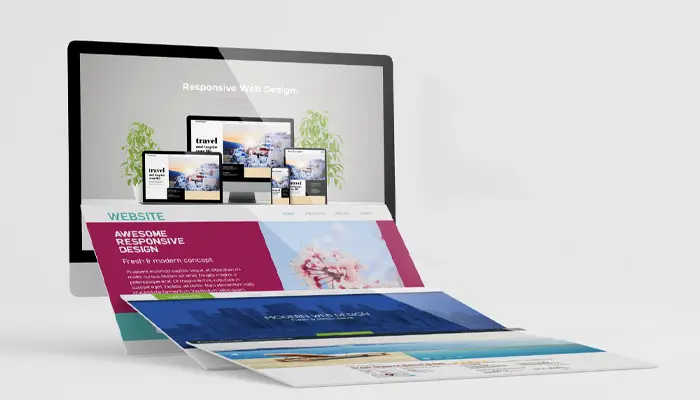
Protect Your Data: Best Free & Paid VPNs for Mobile Devices in 2025
July 21, 2025
How to Optimize Your Website for Conversions: A Beginner’s Guide
July 25, 2025Whether you’re a designer, developer, marketer or content creator, your portfolio is your digital handshake. In today’s competitive landscape, a sleek, fast and responsive website can mean the difference between landing high-paying clients or being overlooked.
But here’s the good news: You don’t need to write a single line of code to create a beautiful, functional portfolio site, thanks to WordPress and intuitive drag-and-drop builders. This guide walks you through a beginner-friendly, step-by-step method to launch your personal or agency portfolio with verified tools and best practices, all validated from leading sources like WPBeginner, ThemeIsle, Elementor Academy and Kinsta (2025 updates).
Step 1: Choose the Right Hosting Platform
Before building, you need a domain name (your URL) and a hosting provider to store your website files. For WordPress, we recommend:
- Bluehost: Officially recommended by WordPress.org
- SiteGround: Fast, secure and known for excellent customer support
- Hostinger: Affordable, great for beginners
Pro Tip: Most of these providers offer one-click WordPress installation and free SSL certificates to secure your site.
Source: WordPress.org Hosting Recommendations (2025)
Step 2: Install WordPress
Once you sign up for hosting, you’ll typically find a “Install WordPress” button in your dashboard (especially with Bluehost or SiteGround). It takes under 5 minutes.
After setup, you can log into your WordPress admin panel at:
yourdomain.com/wp-admin
From here, you’ll control everything: themes, plugins, pages and design.
Step 3: Pick a Clean, Creative Theme
Your theme sets the foundation for your site’s style and layout. The best themes for portfolio websites in 2025 are:
Astra: Lightweight and super customizable
OceanWP: Feature-rich and mobile-optimized
Kadence: Fast loading, built for page builders
Hello Theme (Elementor): Minimalist and ideal if you’re using Elementor
Most of these are free with paid upgrades. They’re fully compatible with drag-and-drop builders and responsive for mobile viewing.
Source: WPExplorer’s Top WordPress Themes for 2025

Step 4: Use a Drag-and-Drop Page Builder (No Coding Needed!)
This is where the magic happens. Instead of editing code, you can drag elements like images, text, videos and buttons into pre-built layouts.
Top page builders:
| Builder | Features | Free Version |
| Elementor | Live editing, templates, animations | ✅ |
| SeedProd | Simple UI, landing pages, maintenance mode | ✅ |
| Divi | All-in-one builder with beautiful design packs | ❌ (Paid only) |
Elementor is the most recommended for creatives due to its ready-made portfolio templates, responsive editing and wide plugin support.
Source: Elementor Academy, Portfolio Tutorial
Step 5: Add Portfolio Pages & Customize Sections
Here’s what to include in a simple portfolio structure:
- Home: Bold intro, hero image, CTA button
- Portfolio/Work: Project thumbnails → click to view details
- About: Brief bio, skills, tools you use
- Services: Design, development, branding, etc.
- Contact: Form, email, social links
Using your page builder, insert sections like:
- Image galleries
- Testimonials sliders
- Skills progress bars
- Animated buttons
- Embedded videos
Bonus: Use tools like Envira Gallery or WP Portfolio Plugin to display your work beautifully.
Step 6: Optimize for Mobile & Speed
With over 60% of web traffic now mobile, your site must load fast and adapt to smaller screens. Make sure to:
- Use responsive themes
- Compress images with Smush or Imagify
- Use LiteSpeed Cache or WP Rocket for performance
- Test on Google’s PageSpeed Insights
Source: Kinsta: How to Speed Up WordPress (2025 Guide)
Step 7: Add Plugins for Extra Functionality
Here are a few essential plugins for a portfolio site:
- WPForms: Easy contact forms
- Yoast SEO: Improve search rankings
- MonsterInsights: Google Analytics made simple
- Elementor Addons: Extra widgets & design options
All are either free or freemium and beginner-friendly.
Step 8: Launch and Share Your Site
Once your site is ready, it’s time to go live and share it across:
- Behance
- Instagram bio
- Email signature
- Freelancing platforms (Upwork, Fiverr, Dribbble)
Make sure to keep it updated, add new projects, optimize for SEO and maintain security with regular plugin/theme updates.
Final Thoughts: Build Now, Grow Later
You don’t need to wait for a developer, learn HTML or invest thousands. With WordPress, powerful themes and intuitive builders like Elementor, you can launch a professional portfolio in a weekend, for free or very low cost.
As a creative director and digital marketing expert, I always advise clients to own their digital identity. Platforms like Instagram or Behance can disappear, but your website is your home base.
If you have any questions regarding “WordPress” feel free to contact us. For inquiries and consultations, call us at: +92 321 4808303 or Email us at: hello@owaisgilani.com.
Disclaimer: The information shared on this website is for educational and informational purposes only and reflects my personal views and experiences. While I strive to provide accurate and helpful content, readers should use their own judgment and consult with a qualified professional before making any decisions based on the information here. I am not responsible for any actions taken based on this content. Feel free to reach out to me if you need clarification or have questions before using any part of this information.



